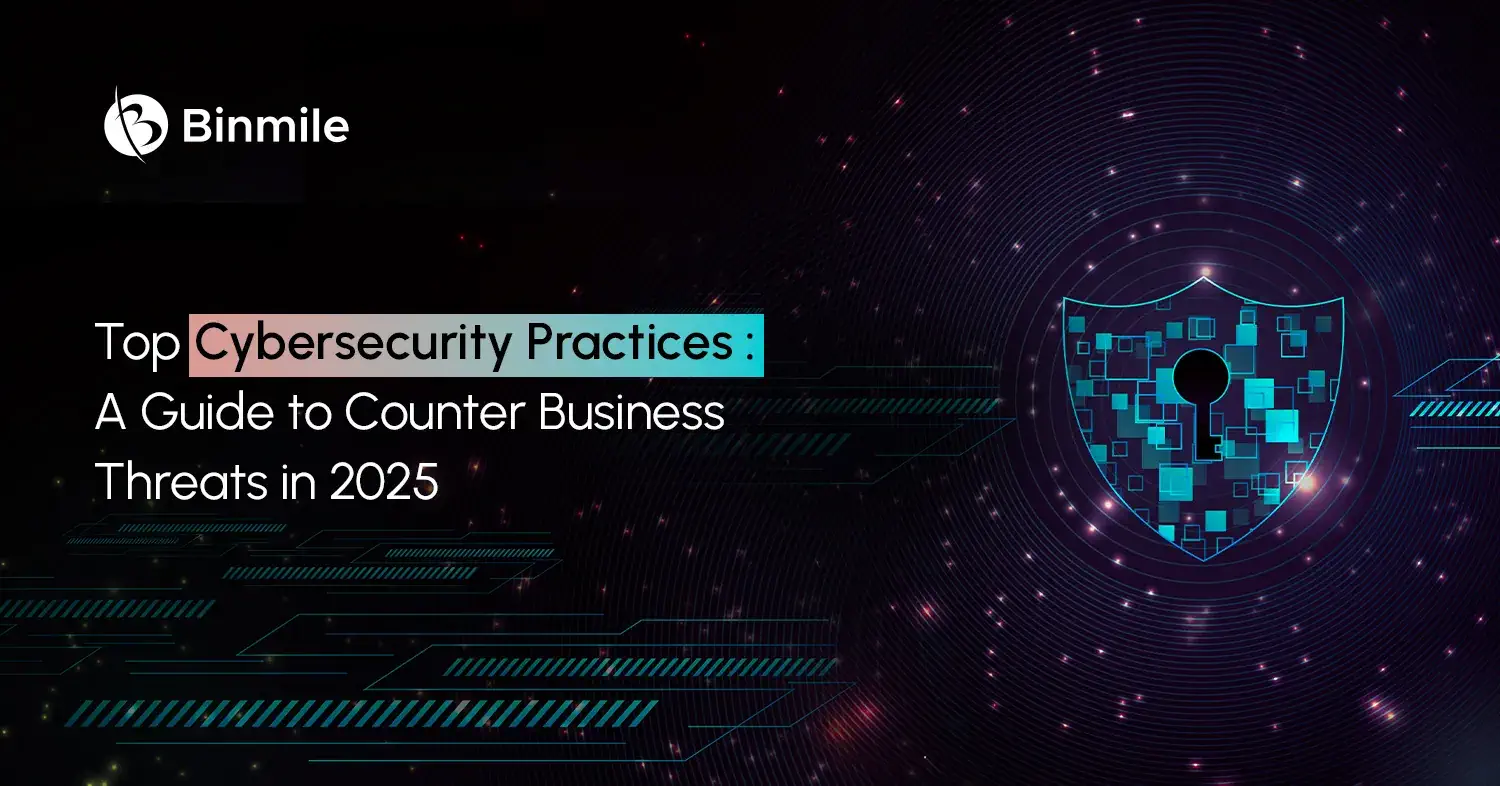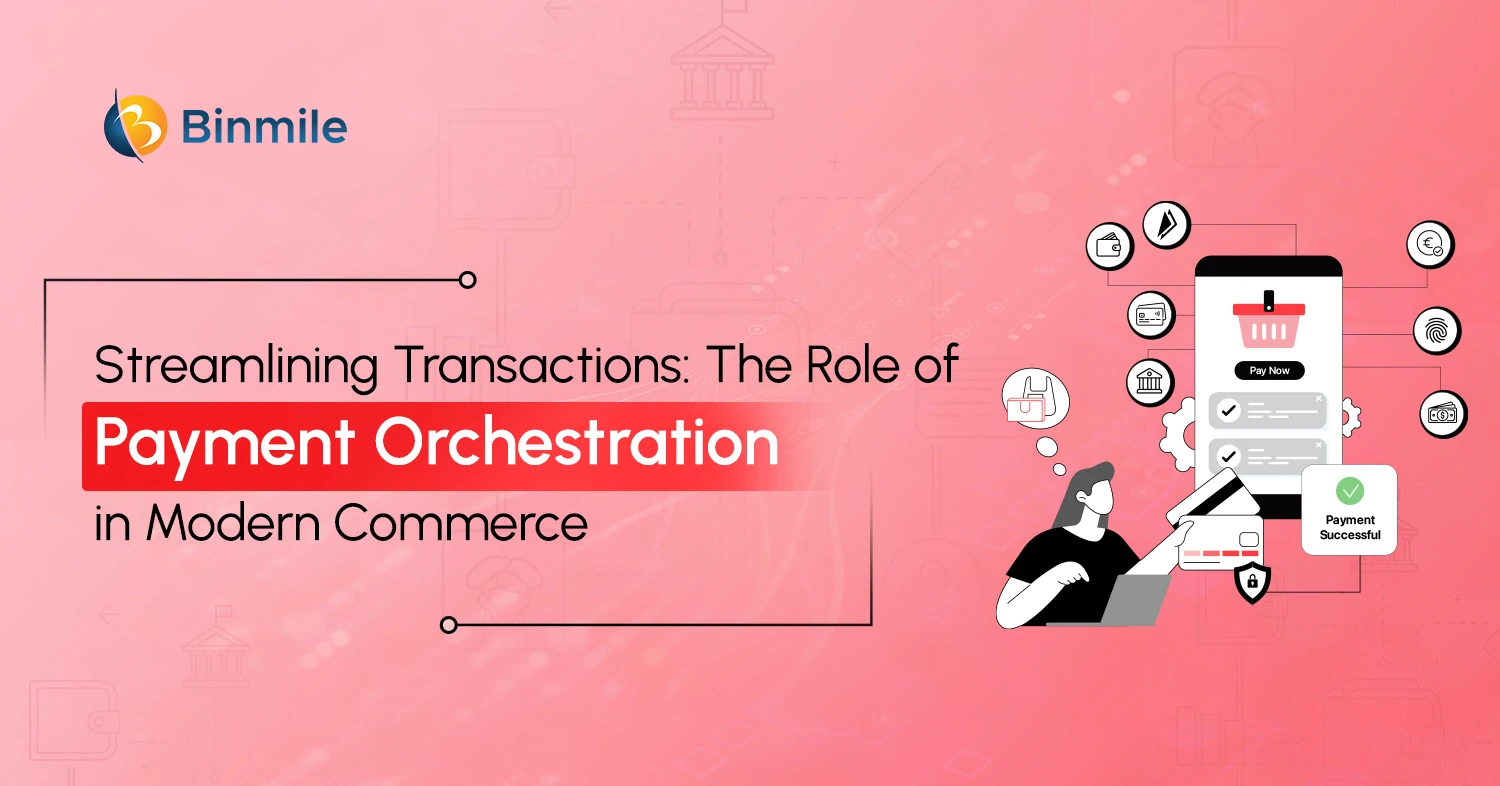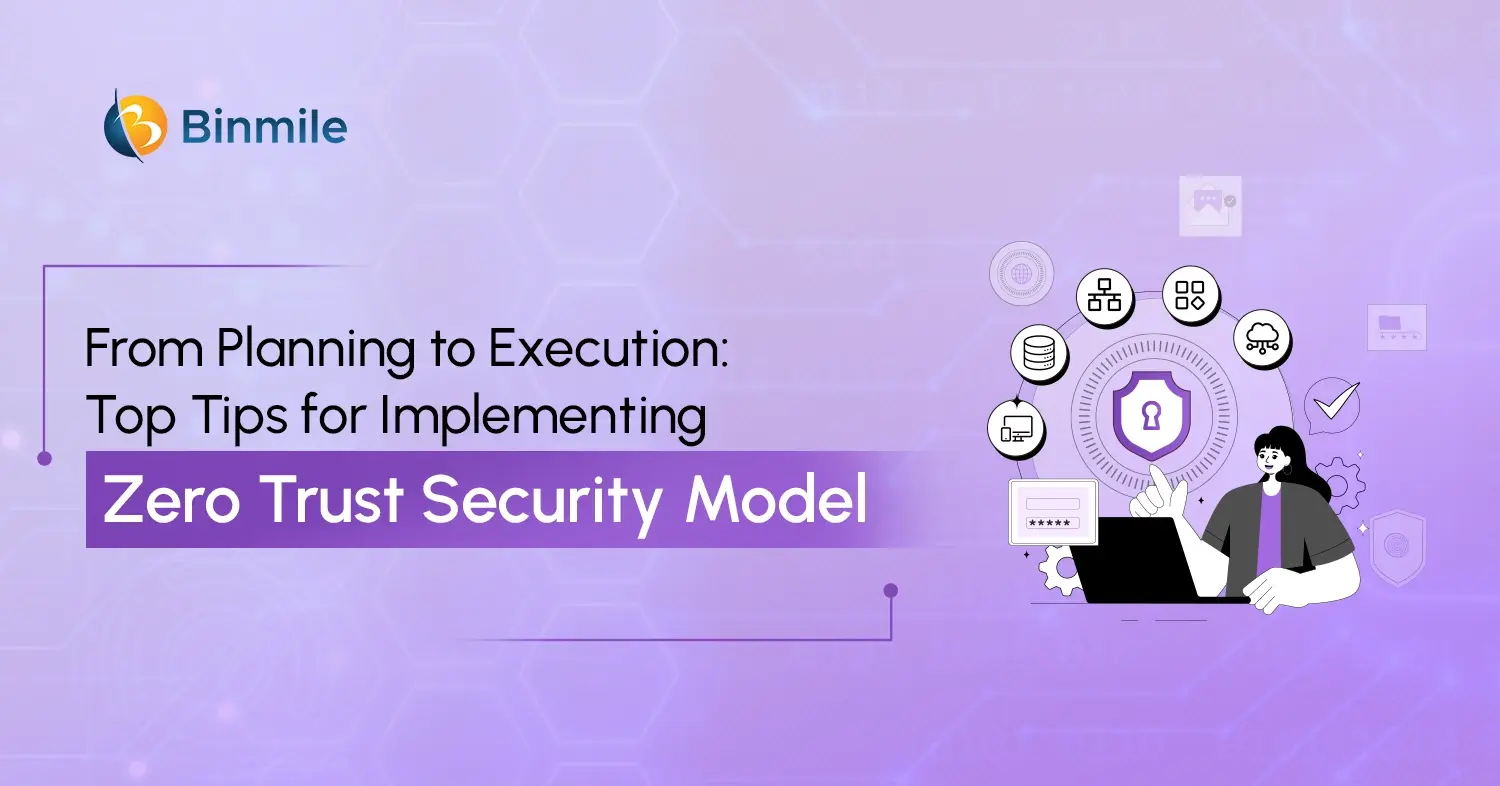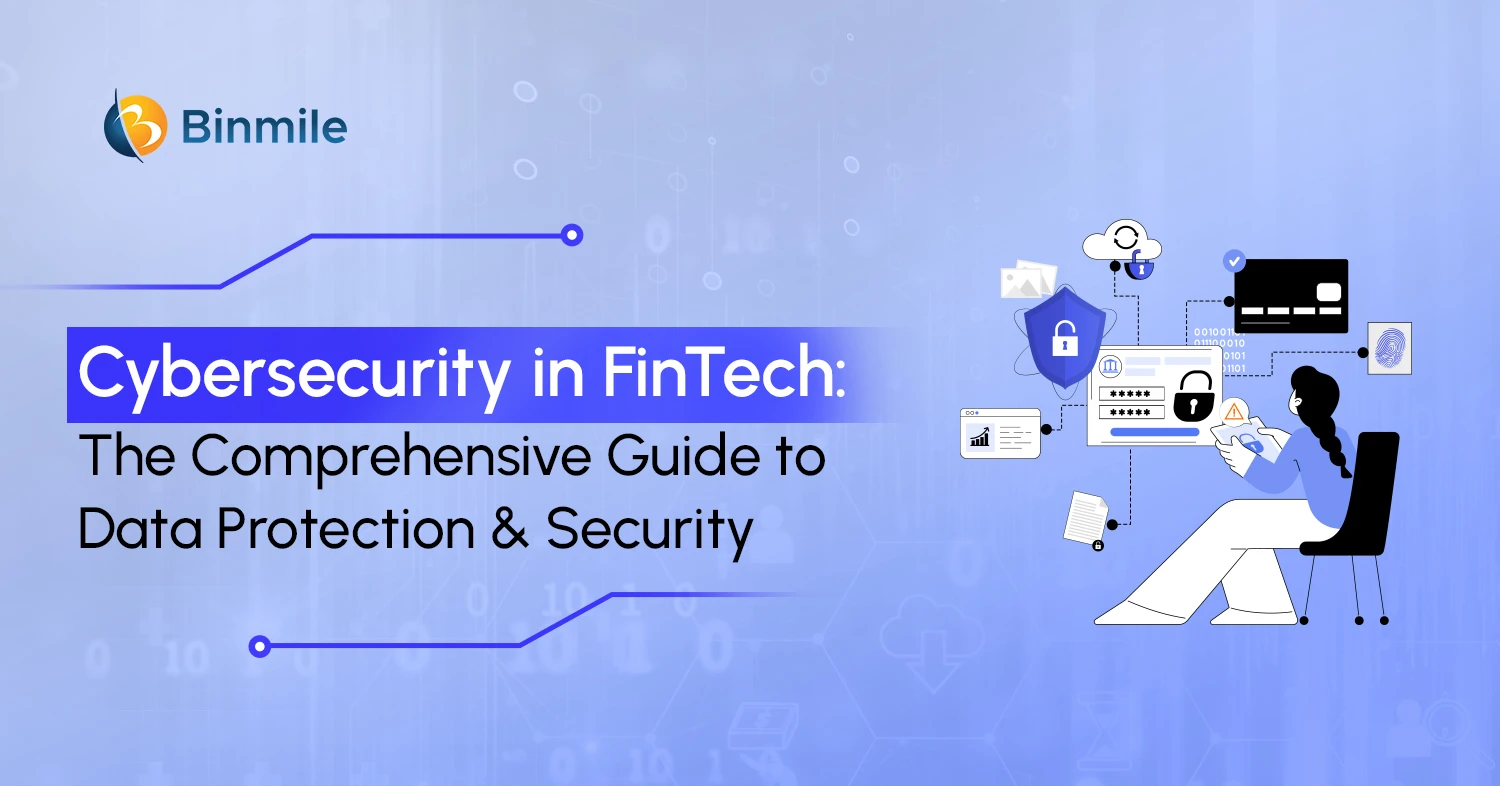The pace at which technological advancements are taking place, the instances of sophisticated attacks are increasing the same way. The dynamic nature of the digital world and the constant evolution of threats make it necessary to implement a slew of preventive measures sooner or later. The upsurge in cybersecurity threats weakens the integrity of data, systems, and networks, highlighting the significance of vigilance for both businesses and individuals. As businesses store more sensitive information, data security becomes a crucial aspect of protecting their assets. Thus, the question arises, how to deal with cyberattacks effectively? Well, we will discuss some cybersecurity best practices for businesses in this blog to tackle common attacks in 2025.
Why is Software Security Important for Businesses?
Software security is a growing concern in the digital age. Cyber threats are quite advanced and require the best possible security to make sure of the complete protection of data for compliance and customer trust. Poor software security brings in serious repercussions, including:
- Financial losses from data breaches
- Theft of sensitive data
- Operational disruptions
- Potential legal penalties
This could further lead to damaged reputations of companies, lost customer trust, and competitive disadvantage experiences. In extreme cases, the impact could extend to business shutdown as well. Understanding these risks highlights the importance of implementing top cybersecurity trends in 2025 to secure assets and ensure long-term success.
The best business cybersecurity practices in 2025 protect your brand’s image and are important for accomplishing success in today’s technology-powered marketplace. Now, it is time to see why incorporating software security measures into your product lifecycle means business success.
- Ensures Your Business Continuity: Adopting cybersecurity best practices for businesses makes sure of a seamless operation without interrupting any activities because of cyber attacks.
- Prevents Your Financial Losses: The cybersecurity measures also reduce the risk of breaches that means no need to pay considerable recovery and remediation costs.
- Maintains Your Customer Trust: Implementing proven cybersecurity tips for businesses helps safeguard customer data and privacy to develop and maintain their confidence.
- Complies with Key Regulations: Embracing cybersecurity measures unconditionally helps meet legal and industry standards, eliminating the scope for hefty fines and legal consequences.
- Enhances Your Competitive Advantage: Such measures show a commitment to security, improving the appeal of your business to security-conscious customers.
- Protects Your Reputation: Integrating essential cybersecurity measures in 2025 protects your brand in instances where there are published security incidents, including but not limited to data breaches or ransomware attacks.
- Supports Your Innovation: Incorporating cybersecurity best practice assists in secure software development and deployment of new functionalities and technologies without tampering with security.
- Strengthens Your Security Architecture: These practices help improve your overall security architecture through security integrated into each phase of the software development life cycle, allowing solid defense against threats.
- Mitigates Your Risks: Leveraging cybersecurity best practices for businesses helps identify and resolve potential security vulnerabilities before they can be misused.
5 Cybersecurity Best Practices for 2025 You Must Know
Leveraging essential cybersecurity measures in 2025 is extremely important for businesses and a strategic priority to protect sensitive data and maintain operational resilience. Sift through five main measures to strengthen your business against potential cyberattacks.
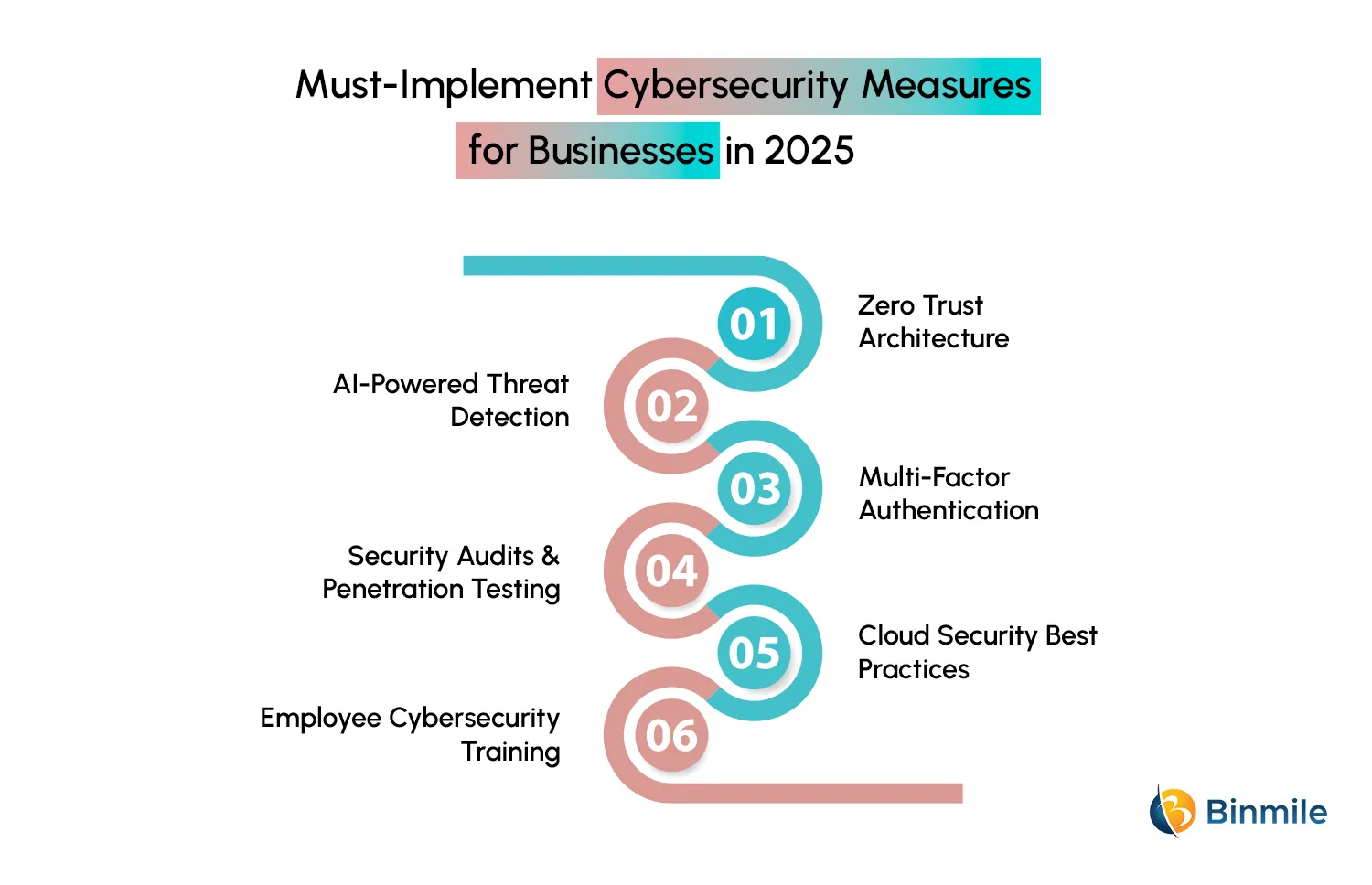
1. Zero Trust Architecture
These days organizations understand the challenges of the cyber world and have replaced the traditional security model with a new approach, i.e., known as Zero Trust Architecture. It is cropping up as a necessity, where trust is never presumed. Rather, every user, device, and application trying to access a network resource is consistently verified and authenticated, despite their location – inside or outside the network. By separating access and applying the idea of minimal privilege, organizations can mitigate the attack surface and reduce lateral movement within their systems.
Implementing Zero Trust aligns seamlessly with the cloud ecosystem, making it a flexible, future-proof, and proven cybersecurity tactic. This is one of the main applications of cybersecurity in business, as it helps businesses make sure that each user and device, irrespective of location, is consistently verified and authenticated prior to accessing resources.
2. AI-Powered Threat Detection
AI-powered threat detection is one of those cybersecurity best practices for businesses i.e., important for staying ahead in the competition with quick resolution. AI systems analyze network traffic, recognize patterns, and learn from past attacks to proactively identify and reduce threats in real-time.
By taking advantage of machine learning and deep learning algorithms, these systems become smarter over time, recognizing slight abnormalities that human analysts might skip. AI improves threat detection and incident response, enabling predictive analysis of prospective vulnerabilities and making sure businesses can neutralize risks before they turn into full-fledged attacks.
3. Multi-Factor Authentication
In the age of frequent password breaches, counting on passwords alone is extremely risky. MFA adds a significant layer of defense by requiring users to offer several forms of verification prior to getting access to sensitive systems. This might comprise a mix of passwords, biometrics, and device-based tokens. Even if a password is leaked, attackers will need a secondary verification form to get desired access. Multi-factor authentication is an easy yet powerful tool to protect against unauthorized entry and is a key requirement for safeguarding valuable business data in 2025. In case, you want to integrate this feature into your application, do connect with the software development company now.
4. Security Audits & Penetration Testing
Staying secure is not about adopting a static solution but continuous enhancement and vigilance. Regular security audits make sure that organizations are not only sticking to industry standards but also recognizing and resolving any potential vulnerabilities in their systems. Penetration testing or ethical hacking enables businesses to imitate real-world attacks, rendering deep insights into weak points that could be misused by malicious actors. By continuously updating these cybersecurity best practices for businesses, organizations in 2025 can stay ahead of sophisticated threats, adapt to regulatory changes, and make sure their defenses are resilient against modern cyber risks.
5 . Cloud Security Best Practices
With more companies shifting to the cloud, protecting cloud environments will become extremely important in 2025. Cloud security best practices for stopping cyberattacks comprise, securing cloud configurations, encrypting data, implementing identity and access management controls, and taking advantage of automation to analyze cloud infrastructure continuously. In this shared responsibility model, cloud service providers and businesses must work in tandem to safeguard data, apps, and services. Organizations also need to take into account potential misconfigurations, which is the main reason for cloud breaches.
Applying robust cloud security protocols will safeguard data integrity, availability, and confidentiality, promoting a secure digital transformation while incorporating cybersecurity tips for businesses into daily practices. As more businesses shift to the cloud and embrace IoT devices, the attack surface continues to enlarge. As per an actionable insight-delivering firm, more than 95% of new digital workloads will be deployed on cloud platforms by the end of 2025 and IoT devices will exceed 32 billion globally. While cloud service providers render powerful security features, the complexity of securing various cloud platforms infuses vulnerabilities, especially when configurations are not managed properly.
Ready to strengthen your cybersecurity? See how our ML development services can enhance your security strategy and protect your business from future threats!

Best Cybersecurity Tools and Practices 2025
1. Wireshark

Wireshark is an open-source console-centric tool utilized to monitor network protocols. Cybersecurity engineers leverage it to evaluate network security weaknesses by continuously capturing and monitoring data packets.
Key Features:
- Compatibility across various platforms, like Windows, Linux, FreeBSD, OS X, etc.
- Open-source architecture with very simple integration
- Several networks and multiple output formats are supported by decryption protocol supports
- Data is recorded and analyzed in real-time, facilitating modern applications security
2. Nmap

Nmap is a free and open-source cybersecurity tool that checks IT systems and networks to discover security vulnerabilities. Further, it allows software engineers to track host uptime, identify possible areas of attacks on the network and service, and take necessary security actions as and when required.
Key Features:
- Network Mapper is compatible with all famous operating systems, which means building a sustainable Android app security system is a breeze with this tool
- Offers an in-depth overview of the activities of the network on a single dashboard, like hosts that are joined with the network, types of packet filters and firewalls deployed to keep the network secure, the OS it operates on, etc
- Despite the size of the network, it allows experts to look for vulnerabilities on the web
3. Metasploit

Metasploit has expertise in penetration testing. It covers a wide variety of security objectives, like designing strategies to enhance the business’s cybersecurity defenses and finding vulnerabilities in systems and networks, among others.
Key Features:
- Tests system security of cloud-based applications, servers, networks, etc
- Provides the ability to see the slightest emerging weaknesses and offers high-level security 24/7, including modern app security resilience
- Helps assess and upgrade IT infrastructure security against vulnerabilities reported previously
- Compatible with a myriad of different systems, comprising cloud-based applications, networks, and servers, among others
4. Sprinto

Sprinto is a cybersecurity and compliance automation tool that performs completely automated checks at the lowest possible level to make sure of immensely tight security across functions. It helps look at security gaps and implement controls to resolve them.
Key Features:
- Create, edit, and manage user access privileges to deter unauthorized access and strengthen essential cybersecurity measures 2025
- Make sure of the implementation of controls, such as firewalls, antivirus, encryption, and more with real-time control monitoring of key infrastructure
- Manage and report endpoint device safety with Sprinto’s built-in MDM tool – Dr Sprinto
- Validate security and compliance health from a central dashboard with an instant snapshot of pass, fail, due, and significant checks
Also Read: Cybersecurity in Fintech.
How Can Binmile Fortify Top Security Practices to Protect Businesses 2025?
Managing cybersecurity for an organization is not a piece of cake. You need a helping hand to build solid mitigation strategies to keep your business operating securely. Thus, your search for that helping hand concludes at Binmile. As a dedicated machine learning development company, we specialize in developing bespoke cybersecurity solutions that suit your business needs, ensuring the highest protection for your valuable data. At Binmile, we prioritize your cybersecurity needs by delivering customized solutions that strengthen your defenses against emerging threats. Below are the pointers that differentiate us from others:
- All-inclusive Security Assessments: We deeply assess your existing framework to recognize vulnerabilities and build customized strategies.
- Employee Training and Awareness: We promote a culture of cybersecurity hygiene by training cybersecurity best practices for businesses.
- Advanced Threat Detection and Response: We leverage Artificial Intelligence and Machine Learning for real-time tracking and immediate breach response.
- Trust and Reliability: We have a proven track record in protecting digital assets, making sure your security needs are fulfilled with perfection.
- Specialization in Secure App Development: We incorporate security protocols throughout the software development lifecycle for powerful protection.
Connect with us to strengthen your cybersecurity strategy and create a resilient framework that supports your business growth while keeping cyber threats in check.
Take your cybersecurity to the next level with our ML development services! We can help you detect threats faster and predict vulnerabilities easily.
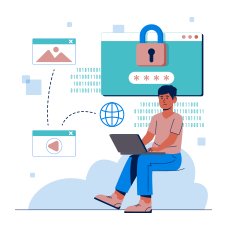
The Rundown
As we enter 2025, the cybersecurity ecosystem will experience the rise of AI-powered attacks, the growing threat of quantum computing, and the increasing vulnerability of social media sites. To stay ahead of such challenges, businesses need to invest in AI-backed defenses, adopt a Zero Trust approach, and integrate web app authentication. In addition to that, companies must prepare for a stringent regulatory environment and the upsurging need for cyber insurance. With cybercrime surging at an unprecedented pace, businesses that fail to adapt to risk are highly likely to become the next victim. Now is the time to take a plunge, protect digital assets, and secure the future with the help of a renowned AI development company.
